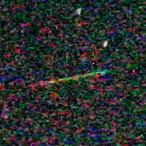After posting my observation of the Alpha Aurigid meteor shower to the amastro yahoo group, a comment was raised about the photo I included in the report. A member of the list thought it was doubtful that the object in the photograph was a meteor. This was mainly due to the lack of tapered ends and the uniform brightness of the streak of light. His thought was that this was more likely to be a satellite trail that cut in and cut out at the beginning and end of the exposure (resulting in blunt tips on the trail). This is a reasonable objection. Honestly, I thought it was not a typical shape for a meteor light trail either. However, here is why I felt confident that it was a meteor despite its shape.
- The trail seems fairly short (about 1.5 degrees long in this case) to be a satellite trail on a 30 second exposure.
- Each of the photos I took that morning was broken by a pause of only 3-5 seconds before the next shot was taken. I did not see a continuation of this trail of light on either the proceeding or following exposures. If the satellite’s progress was indeed cut off at the beginning and end of the exposure, it seems likely that it would have shown up on at least one of those other shots.
- The color change across the length of the streak is similar to a number of other meteor photos from that morning: blue-green at one end and red at the other. I’m not sure that a satellite streak would do that. But perhaps they do?
- I did in fact record a satellite trail on three of my exposures several minutes after this shot was taken. While this satellite capture did exhibit a uniform width and blunt ends, it didn’t follow these previous characteristics. Its trail was significantly longer. It was traceable across more than one exposure. And it didn’t exhibit a color shift across its length.
I’m not saying this is proof of meteorship. But I did try to do my homework before publicizing it. A couple things I’m interested to pursue after considering this are: 1) Are there any other meteor photos that demonstrate blunt ends and uniform width, and 2) Was my noise processing partly to blame for the bluntness of the image?
While I ponder and research this, here is the image in question with no noise processing:

I’m open to any comments.
Hi Jeremy,
This is probably a very long shot but,I wonder if it could have been a very dim Iridium flare?.
Andrew
I had exactly the same experience with my Perseid shoot. I had a definate satellite that was present over two frames, and recorded three meteors, which i did have some doubts over. Also i saw some meteors in the camera field, but they were not recoreded either.
Possibly the ends are blunt because we are pretty near the noise floor ?
I have placed my images on our local society website – go to the second page of the gallery at:
http://cotswoldas.org.uk/cas/index.php?option=com_content&task=view&id=40&Itemid=2&limit=1&limitstart=1
(these are unprocessed – except resize, the inset are original full size).
Andrew and Callum, thanks for your thoughts. I think the Iridium flare would have the same issue as calling it a meteor, in that Iridium flares also should have gradual brightening and fading rather than blunt ends. Callum, I think what you said might be the problem: “Possibly the ends are blunt because we are pretty near the noise floor?” Thanks for the link too–your capture looks a lot better than what I got.